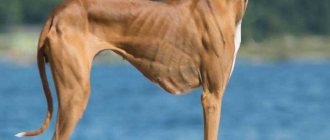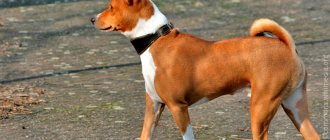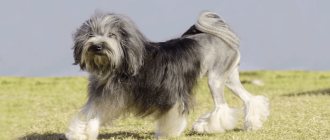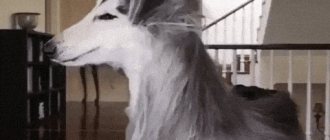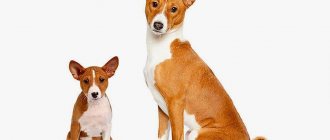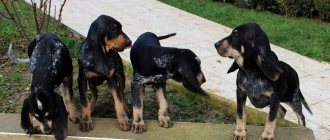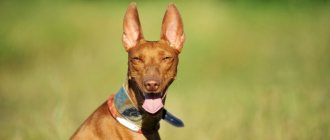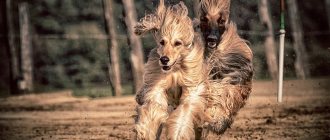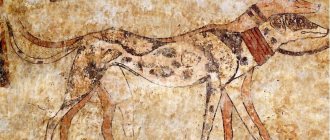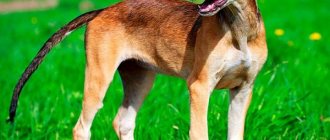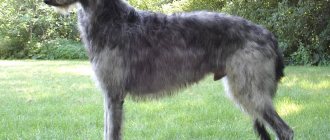| Origin: | Africa |
| Usage: | hunting, guarding, companion dog |
| Color: | red, sand, black |
| Dimensions: | height of males up to 70 centimeters, females - up to 65 centimeters |
| Lifespan: | 12-14 years old |
The Azawakh comes from Africa. Almost no selection was carried out on the breed. Its representatives are primitive dogs. Primitiveness means complete preservation of the original appearance. Included in the list of the rarest dog breeds.
Description
The Azawakh is a textbook on canine anatomy. They are that thin. The emaciated animal appears to be on the verge of death. This is a misconception. The Azawakh is a dog breed that is one of the hardiest in the world. Her thinness is defined by the standard.
Characteristics:
- The height of the animal reaches 70 centimeters. These are males, females are shorter - up to 65 centimeters. Weight should not exceed 25 kilograms. The weight range is large - from 13 to 25 kilograms. It is not surprising that with such height and weight, representatives of the breed seem emaciated.
- The head seems small. It is similar to a fox's muzzle, narrow and long.
- The ears are semi-dropping and widely spaced.
- The eyes are almond-shaped, brown in color. Small, closely planted.
- Large and black nose.
- The jaws are narrow and weak.
- The neck is long.
- The body is muscular and elongated.
- The dog's paws are very long and thin.
- The stomach is retracted.
- The tail is saber-shaped.
- The coat is short and the hair is fine. There is no fur on the belly.
- Acceptable colors are red, sand and black. African Azawakhs come in a variety of colors. There is no clear standard. It applies to European representatives of the breed.
Brief characteristics of the dog
- Other dog names: Tuareg Greyhound, Azawakh hound, Blue Berber Greyhound, Tuareg Sloughi, Tuareg Sloughi, Azawakh, South Saharan Hound.
- Adult height: 64-74 cm.
- Weight: 15-25 kg.
- Characteristic color: red-brown with white “stockings” on the paws and a white chest.
- Coat length: very short.
- Life expectancy: 10-12 years.
- Advantages of the breed: loyal, affectionate, good guard and hunter, smart, hardy.
- Difficulties of the breed: distrustful, non-communicative.
- Average price: from $500 to $1000.
Character
This breed has a complex character. Azawakhs are independent. He does not like affection and avoids touching. Perhaps the behavior is related to distant ancestors. Nobody caressed them. The human hand is a source of pain for them. The Berbers were distinguished by their cruelty; they easily used physical force against their pets.
Despite their independence, the Azawakh dog breed is devoted to its owner. The animal obeys only him. He is friendly with other family members, but remains neutral.
Doesn't like strangers. Extremely suspicious of them. An Azawakh won't bite, but it can knock you down. The fact is that in their homeland, the Azawakh dog breed served as an “alarm signal.” The animals spent the night on the roofs of houses. The Berber houses were low. The dog calmly climbed onto the roof and slept there.
When a predator or stranger approached, the Azawakh would bark loudly, notifying the owner of the danger. The uninvited four-legged guest had a hard time. The greyhounds tore him to pieces. The stranger walked away with fear. The African greyhound would knock you down, lie down next to you and guard you until the owner appeared.
Azawakh (FCI name) loves freedom. Racing under the hot sun in pursuit of prey is in his blood. In Russia there is no such sweltering heat as in the homeland of dogs. Sand is replaced by fields and forests. The animal will happily run through the fields. Play or hunt field mice, releasing pent-up energy.
Not suitable for apartment living. The Azawakh dog breed needs long runs. Providing them in the city is problematic.
Interesting facts about the Azawakh
The Azawakh is an ancient breed, about which a lot of interesting things can be told:
- The fleet-footed and tireless African hound is capable of chasing prey for more than 5 hours, moving at a speed of 60-65 km/h.
- Having overtaken the animal, the Azawakh does not kill it, but gnaws its tendons and holds it until the owner arrives. Thanks to this, the African greyhound is highly valued by the Tuaregs and is held in their special regard. The dog is surrounded with care and allowed into his tent.
- The absence of excess fat, thin light bones, flat belt-like muscles and short, sparse hair help the Azawakh to withstand the sweltering heat.
Socialization
The Azawakh does not like children. They make a lot of noise, which dogs cannot stand. The nature of the Azawakh is such that the animal does not tolerate intrusion into its personal space. Begins to actively defend itself against the troublemaker. Children, especially small ones, do not understand this. The dog makes them curious and tries to get to know each other. The child violates the dog’s space and receives a decisive rebuff.
Kids are restless and active. They can't sit still, they need to run. Running around will turn on the dog's hunting instinct. She will catch up with the child and knock him down. Therefore, it is better to refrain from buying a representative of the breed if there are very small children in the house.
The dog is loyal to his own kind. Since ancient times I have been accustomed to a large number of dogs in a pack. Azawakhs have a dominant character. Among their own kind, they will decide who is in charge here. Fights are possible between them and other dogs, until a hierarchy is established.
Cats for representatives of the breed are prey. An Azawakh can be made friends with a cat if the animals have been together since childhood. But the domestic cat is his own and cannot be touched. Street cats are strangers, objects of hunting.
Rodents and birds are on the same level as cats. Prey that must be caught.
Proper nutrition
The Greyhound breed does not have any dietary peculiarities. They easily eat the same food as other breeds.
The only difference in the diet is that the products should contain a lot of calcium, since animals have a fairly developed skeleton that needs regular reinforcement.
Don't forget to give your pet big bones so that he remembers his hunting skills.
How to choose a puppy
Azawakh puppies are nimble and active. A beginner is not always able to choose a good dog. There are recommendations for choosing a baby.
When buying a puppy, pay attention to its behavior. If the prospective pet behaves impudently, offends its sisters and brothers, and runs around the house like a hurricane, it is worth adopting. He will grow up to be an excellent dog, fearless and loyal.
Training
It is difficult to train this dog; outright coercion and harshness cannot be applied to it. In response to the aggression of the trainer, the Azawakh either shows aggression or withdraws into himself and further relationships with the person will be difficult. The main thing is discreet love, praise and food encouragement.
The dog is not for group exercises in a common area! She will not tolerate competition.
These dogs should have short, sonorous and sonorous nicknames - like any hunting dog: Grif, Jug, Boy - for a male. For a bitch - Gray, Berta, Zara, etc. In a good kennel, a puppy receives a name at birth that begins with the same letter.
Garde-Epee is considered one of the best Azawakh nurseries. This is a French line. In Russia you need to look for dogs of this breed. How to choose a puppy: you should look at your future pet no earlier than one and a half to two months. Not only the exterior, the condition of the coat and the musculoskeletal system are assessed, but also the character: human-orientedness is determined early. A cowardly or aggressive puppy is a breeding defect. The price of an Azawakh puppy starts from $350. French dogs can cost several times more.
Features of maintenance and care
The African Greyhound is content with the minimum. She does not require special care. The owner should know that the animal does not tolerate cold well. The Azawakh can withstand monstrous heat. But it will die from sub-zero temperatures, which other breeds can withstand without problems. Greyhounds from Africa need warm clothing. This will help her survive the cold season.
Combing
If you look at the photo, the Azawakh appears to be hairless. This is a deceptive impression; the representative of the breed has fur. It is so thin that it is enough to brush it once a week.
Bathing
The dog hates water. In rainy weather he prefers not to go outside. When he encounters a puddle, he will take the tenth route around it. Bathing a pet is torture. And there is no need to torture him more than once a year.
Walk
African Greyhounds need long walks. An Azawakh deprived of physical activity will find use for its energy. He will make a dig, leave the enclosure, and restore “order” in the garden.
Walk dogs at least five to six hours a day. If possible, let him walk around the garden all day. In winter, it is advisable to refrain from such walks.
Feeding
In Africa, the Azawakh eats what it catches. The owner feeds him with leftovers from his table. Nobody makes a special dog menu.
In Europe, the attitude towards dogs is different. Breeders feed them meat and vegetables. Beef or veal is the basis of the diet.
Other breeders prefer super-premium dry food with the addition of vitamin E.
Adult dogs are fed twice a day, puppies more often. Five to three times, depending on age.
History of the origin of the species
The Azawakh is one of the purest breeds in the world and has not been crossed between species for many centuries. The exact date of birth of the first dog is not known, but experts place it at 20-18 centuries BC . This was determined with the help of cave paintings of ancient people, who developed the breed. Cynologists claim that her ancestors were Slugi and Saluki - the most ancient dogs belonging to the group of greyhounds.
The first tribes they served are called Tuareg. That is why the Azawakhs were nicknamed Tuareg Greyhounds. The tribes were warlike and needed to protect their territories, which the Azawakhs did well. Dogs also helped in hunting.
The place of origin is easy to determine. The hottest and harshest continent is Africa . More precisely, Southern Sahara is the delta and the entire course of the Niger River. The place where the largest population of Tuareg hounds accumulated was the Azawakh Valley, which gave this breed its second name.
Despite the ban on the export and sale of dogs from Africa, these greyhounds gained popularity in Europe in the 70s of the twentieth century. This happened thanks to the French ambassador Pequer, to whom the African tribes presented an Azawakh male as a thank you for saving them from a wild elephant. Later, the same tribes gave him a female. Pecker was the first to introduce Tuareg Greyhounds to France.
There is a theory that the first Azawakh breeding country in Europe was Yugoslavia, and that the Africans did not give the dog as a gift, but allowed trade in the breed.
The Azawakh breed was officially registered in 1981, and in 1993 the FCI world standard was recognized.
At the moment, the population of Tuareg hounds in Africa is rapidly declining. There are not enough resources to raise and educate all the dogs, so nomads choose only one of the litter, usually the strongest. The remaining puppies are killed. It is believed that this way the dog will become stronger, because the mother will feed her only son, and not all of them at once. During the rainy and fertile seasons, up to three pups may be kept.
The population also suffers from attacks by wild animals and predators, which can easily cope with the Azawakhs.
Health
Greyhounds from Africa are some of the healthiest dogs on the planet. What other breed can adapt to sweltering heat, lack of food and water in the required quantities and hunting under the hot sun.
Azawakhs have no genetic diseases. The only peculiarity of the breed is intolerance to cold. Starting from early autumn until late spring, the pet must be taken into the house. Take them out for walks in warm clothes.
Vaccinations
Standard complex. The first vaccinations are given by the breeder. Subsequent annual ones are the owner. The complex includes vaccination against rabies, distemper and infectious diseases.
Price
The cost of the dog is not too budget. Therefore, you definitely won’t be able to buy an Azawakh for pennies. Officially registered breeders are ready to offer prices from $500 and above.
Azawakh puppies
However, the price may be higher. It all depends on the gender of the puppy, its pedigree, the merits of the parents and class. In nurseries, the cost may be slightly lower than from breeders. However, factors such as age and pedigree also play a role here.
Mating
In the homeland of the Azawakh, the question of mating will seem funny. Nobody is watching this. If a bitch becomes pregnant during her first heat, her owner will not worry.
Breeders are stricter about matings. Males and females over the age of two years are allowed. Those who have received permission for breeding and have passed a veterinary examination. Mating will take place only if veterinarians do not find any abnormalities in the intended parents. This practically never happens; dogs are in good health.
Dog names
By the time you purchase a puppy, it will already have a name that is included in the metric, and is also pedigree and official. Whether you use this nickname in everyday life or give it another is up to you. The following nicknames may be suitable for the African hound:
- for males - Allen, Zidler, Gurkhan, Anzhey, Gringo, Dave, Lambert and others;
- for bitches - Zakira, Veggie, Michi, Jaina, Nike, Besta and so on.
As well as other names and nicknames that will be well perceived by the dog by ear, easy to remember and pronounce.
Related breeds
Saluki
The Saluki is called the gazelle dog, and it is rightfully considered one of the first breeds bred by man. This animal is graceful, beautiful and has a complex character. Not every person can get along with her, but if you raise her correctly, the Persian Greyhound will become the best friend for the whole family.
peaceful and affectionate in nature . To simply say that the Saluki breed is the most peaceful of all hounds means to tell very little about it. She is very friendly, but can be touchy and nervous. They need attention . These dogs do not like to be left alone. They simply love to run and jump with members of their “pack”. Salukis have a very high intelligence and at the same time have a characteristic independence. A companionship relationship must be established between the dog and the owner. At the same time, you should not delude yourself that the greyhounds will unquestioningly obey your orders. In most cases, she is submissive, but can be disobedient if she smells prey.
Saluki is not the easiest breed to keep . These dogs are willful, intelligent and love to have their own way. But it is also a beautiful, loyal and energetic pet, for which the owner is the most precious creature in the world. And every Persian greyhound owner will confirm this. That is why these dogs are valued not only in the Middle East, but throughout the world.
